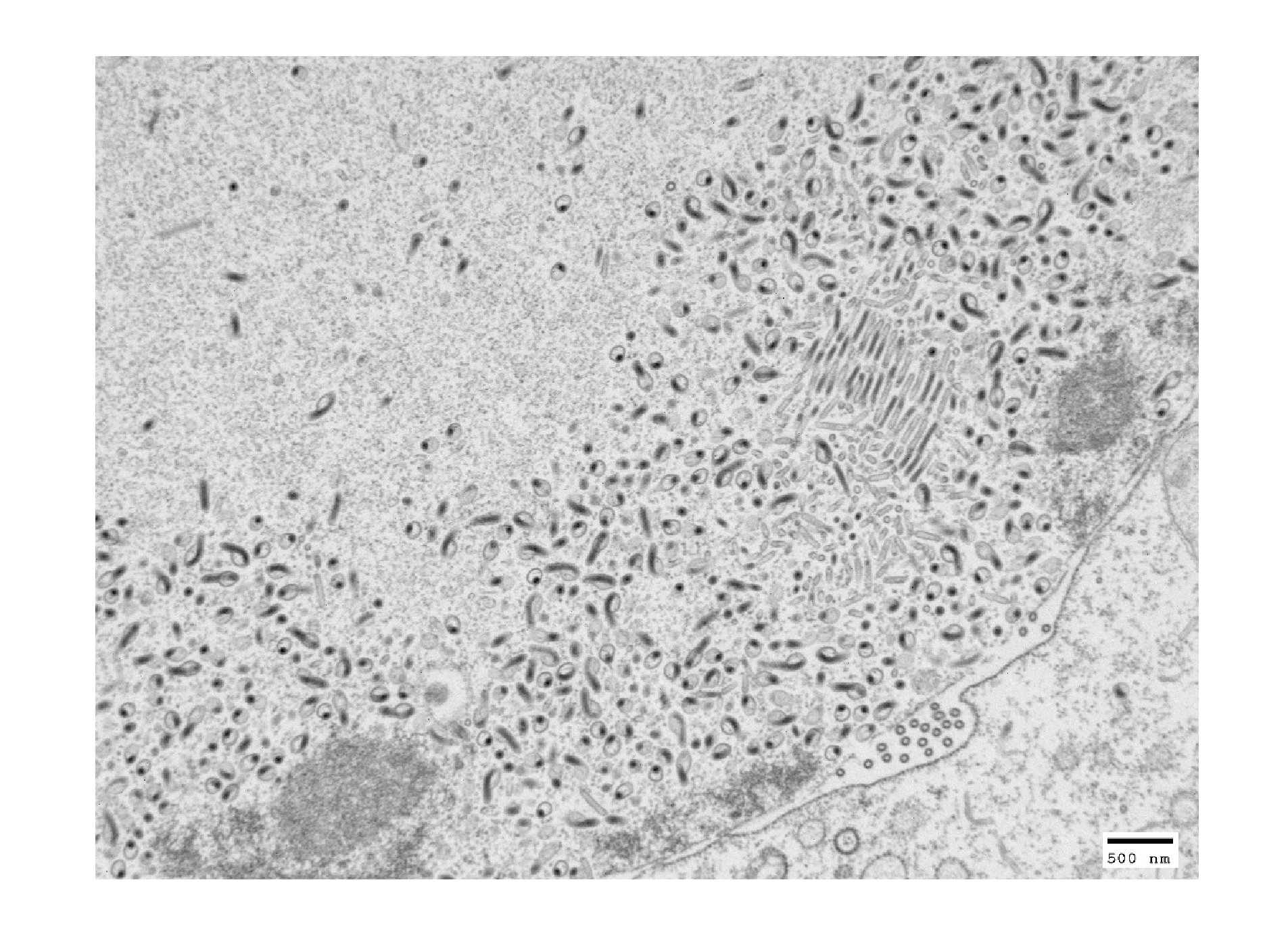Family: Nudiviridae
Genus: Gammanudivirus
Distinguishing Features
The genus Gammanudivirus currently includes four species. Viruses classified in this genus have been found in aquatic crustaceans of the order Decapoda. A related not yet classified nudivirus (Dikerogammarus haemobaphes nudivirus, DhNV), has been described for the amphipod Dikerogammarus haemobaphes ((Allain et al., 2020). Two gammanudiviruses were isolated from shrimp species, Penaeus monodon nudivirus (PmNV) infecting the giant tiger prawn (Yang et al., 2014) and Crangon crangon nudivirus (CcNV), observed abundantly in the brown shrimp (Van Eynde et al., 2018, Bateman et al., 2021). Other gammanudiviruses were isolated from the European lobster Homarus gammarus (Homarus gammarus nudivirus, HgNV; (Holt et al., 2019)) and the European shore crab Carcinus maenas (Carcinus maenas nudivirus, CmNV; (Bateman et al., 2021). Virion structure has been shown to vary slightly between species, however in general they contain a rod-shaped nucleocapsid with a close-fitting trilaminar envelope. CcNV and CmNV are characterised by a typical bulb shaped protuberance of the envelope at one end of the virion (Figure 1.Gammanudivirus). HgNV nucleocapsids have a kind of bended, “u” or “v” shaped appearance (Holt et al., 2019), which so far is unique to this species. PmNV is an occluded nudivirus that forms occlusion bodies with numerous single enveloped nucleocapsids inside. The presence of OBs has led to the earlier names as Monodon baculovirus (MBV) and Penaeus monodon nucleopolyhedrovirus (PemoNPV). The PmNV OBs are acid sensitive (Yang et al., 2014), in contrast to baculovirus OBs that disintegrate under alkaline conditions. The other known gammanudiviruses are not occluded.
 |
| Figure 1.Gammanudivirus. Carcinus maenas nudivirus (CmNV) virions within an infected nucleus. Virions contain a rod shaped, electron dense nucleocapsid surrounded be a trilaminar envelope with a bulb shaped protuberance at one end. Virions appear to accumulate at the periphery of the nuclear membrane. TEM. Scale bar = 500 nm. Image: Kelly Bateman. |
Genome organisation and replication
The size of the circular dsDNA genomes varies between 107 kbp and 132 kbp, while the number of predicted ORFs ranges between 97 and 115 in this genus.
Biology
PmNV is the causative agent of a spherical polyhedrosis in shrimp, first reported in Taiwan in Penaeus monodon (Lightner and Redman 1981). The pathogen is now wide-spread along the Indo-Pacific coast. PmNV affects post larvae, juveniles and adults of various penaeid shrimp and targets the epithelia of the hepatopancreatic tubule and the duct, as well as the anterior midgut cells in very young post larvae (Lightner et al., 1983). HgNV, CmNV and CcNV have been observed in the European clawed lobster (H. gammarus), European shore crabs (C. maenas) and the brown shrimp (C. crangon), respectively (Holt et al., 2019, Bateman et al., 2021). CmNV was also detected in Canadian C. maenas crabs (Bojko et al., 2018). These three viruses manifest by infecting the epithelial cells of the hepatopancreas tubules. The nuclei of infected cells have an enlarged appearance with marginalised chromatin and esoinophilic inclusion bodies. Infected nuclei may appear singly or in clusters within the hepatopancreas tubules, with infected cells often appearing separated from the neighbouring cells and in some cases expelled into the lumen of the tubule. In severe cases of CcNV infection large areas of the hepatopancreas were reported to become necrotic with loss of the tubular structure, leading to the suggestion that this may lead to dysfunction of the hepatopancreas (Stentiford et al., 2004).
Species demarcation criteria
Species demarcation criteria are not well-defined. The species of Gammanudivirus are distinguished on the basis of differences in genome size and G+C content, gene content and arrangement, phylogenetic relationships, host tropism, pathobiology and virus transmission.
Related, unclassified viruses
|
Virus name |
Accession number |
Virus abbreviation |
Reference |
|
Dikerogammus haemobaphes nudivirus |
DhNV |
||
| Callinectes sapidus nudivirus | CsNV |
Virus names and virus abbreviations are not official ICTV designations.

